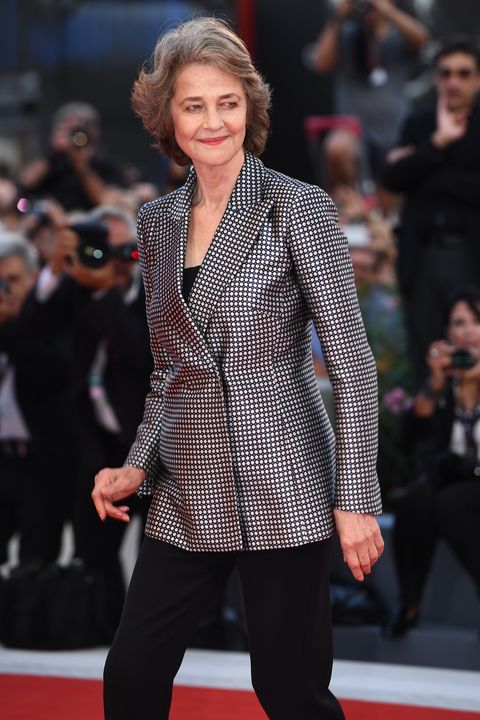On a shopping outing, Jane Bourland informed her granddaughter, “I can’t wear sleeveless. I can’t wear short. And I can’t wear low-cut.” Surveying the styles on the racks at the department store, her granddaughter quickly realized that didn’t leave many choices.
For many older women, like Bourland, finding flattering, fashionable clothing options can be challenging. A growing number of retailers are vying for their dollars, but older shoppers still need resourcefulness, patience and savvy to look put-together.
“The fashion industry is geared to young women who are a size 2,” said Jan Tuckwood, 65, a retired fashion editor. “You can find clothes that look great at any age, but you may need to look in new places.”
While finding appealing clothes gets trickier, many women say they discover new freedom in clothing choices in later life. Nancy Shenker’s work uniform in the 1980s was nude hose and suits with big shoulder pads, following the power-dressing prescription in John Malloy’s 1975 bestseller, Dress for Success. Now, at 65, Shenker continues to work as a marketing consultant but feels freer to dress as she pleases. She wears an updated version of what she calls her “1970s hippie style”—flowy, bohemian tops, boots and hoop earrings. Several years ago, she made a best-dressed list in her hometown of Westchester, NY.
“Finding my style again has been liberating,” she said. “Plus, as an older woman, I really don’t care what anyone else thinks.”
Susan Jones Knape, 66, has read Vogue magazine cover to cover since she was a teenager. After starting her own business a few years ago, she too feels more freedom to follow fashion.
“Before, I squashed my fashion sensibilities in the workplace,” she said. “I thought I would be taken less seriously if I looked fashion-forward. Now, I’m having more fun than ever. I don’t feel impeded by having to look a certain way.”
The freedom that comes with older age was celebrated in the popular 1992 poem, “Warning,” by Jenny Joseph, which reads in part, “When I am an old woman I shall wear purple / With a red hat that doesn’t go, and doesn’t suit me.” Joseph wrote that she will “make up for the sobriety of my youth,” when she no longer needs to worry about responsibilities or to “set a good example for the children.”
The poem inspired the Red Hat Society, founded in 1998 for women 50 and up, which now boasts more than 20,000 members worldwide. But members say it’s more about socializing than daily fashion choices. The group meets for meals and outings, always sporting red hats and purple clothing. (Younger women were admitted in recent years, but they wear lavender and pink.)
“It’s about growing older with fun and grace,” said Sandi Goldbach, who presides as “Queen” of a Dallas-area chapter. “When you’re young, you dress to impress. When you’re older, you have fewer opportunities to dress up and go out.”
Youthquake’s Legacy
Toni Thomas, 66, and her sister, Dollie Thomas, 63, remember the crisply ironed house dresses and aprons worn every day by their grandmother, who refused to wear pants most of her life. Similarly, their mother’s closet was filled with church dresses, each paired with carefully chosen matching accessories: a full slip, high-heeled shoes and jewelry.
By contrast, the sisters enjoy much more freedom to dress comfortably and creatively. Both retired, they’ve hung up the dark suits and blouses of their working days and now choose comfortable options like sneakers and leggings most days. But they still enjoy shopping, trying new fashions and looking fashion-forward.
As women in their 60s, the Thomas sisters benefited from the fashion revolution of the 1960s, which Vogue dubbed the “Youthquake.” Fashion became more youth-oriented, more individualistic and less rule bound. Now, older women today feel more freedom than previous generations.
“Prior to 1970, the industry would promote changes in fashion, especially skirt lengths, and most women who were tuned into fashion would adjust,” said Catherine Amoroso Leslie, a professor at the School of Fashion at Kent State University.
In 1970, the fashion bible Women’s Wear Daily declared the miniskirt was dead and the midi was in—but consumers rebelled. They initially spurned the midi. Women started wearing pants in more and more settings. Gone was the annual ritual of taking up or letting down hemlines as fashion authorities decreed. New fashions originated in the streets of London and New York, rather than the ateliers of Paris.
“It was the start of the consumer having more power in what the industry was producing,” Leslie said. “Women began making choices rather than blindly following dictates.”
Perhaps reflecting that sensibility, many women interviewed for this story bristled at the notion of “age-appropriate” clothing.
Sixty years ago, women didn’t feel the same pressure to look young.
“That implies there’s a rule book,” said Tuckwood, who edited fashion sections at the Denver Post and other newspapers. “It sounds like a way to put women in their place. I have long blond hair, almost to my waist. Some would say that’s not age appropriate. But when you reach a certain age, you can do whatever you want.”
Tuckwood prefers to think in terms of “body-appropriate” clothing, but that’s where clothing choices get more complicated. As they age, women tend to get rounder in the middle and flatter in the rear end. Skin gets wrinkly, making sleeveless tops or bare legs less appealing. Body parts sag; an older woman’s breasts aren’t perched as high as those of a young woman. Stiletto heels become a safety hazard as balance becomes more precarious. Even Knape—who’s still the same size she was in high school—avoids sleeveless tops. Shenker still wears short skirts, but only with black tights.
Finding clothes that are body appropriate is something that Hilde Schwartz, 93, has contended with all her life. She sees maturity as an advantage because she benefits from the hard-earned wisdom from past mistakes. Schwartz, whose career included stints in retail and the apparel industry, recalled spending $500 in the 1980s on an expensive jumper in then-trendy Ultrasuede (a suede-like synthetic fabric) because “Everybody in my synagogue was wearing Ultrasuede back then.”
The fabric didn’t flatter Schwartz, who is short, full-busted and “on the chunky side.” From that and similar experiences, Schwartz says she honed a critical eye for what works and what doesn’t work for her body.
“I learned that I don’t have to wear what everybody else does,” she said. “The older I get, the more I feel that way. With age, you gain a little acceptance and some smarts about what can and can’t be done.”
Sixty years ago, women over 40 did follow more rigid prescriptions for dressing appropriately, according to Linda Przybyszewski, an associate professor of history at Notre Dame University and author of The Lost Art of Dress (2014). But that was viewed as a privilege, not a limitation. Women didn’t feel the same pressure to look young. Sophisticated styles were aimed for women 30 and older; older women disdained the idea of dressing like teens or young women.
“Today, ‘matronly’ is the worst thing you can say about a look,” she said. “But matron used to be a word that conferred respect and dignity. You might see a ‘Hats for Matrons’ section in the Sears and Roebuck catalog, with hats in colors and styles suitable for older women.”
More Options
Many older shoppers find that a single trip to the nearest department store doesn’t work for finding clothes that are body appropriate. Sometimes, the process involves trial and error, a bit of persistence and a willingness to return garments that don’t work.
At the same time, shoppers have more options. Online shopping offers a wider range of choices in more sizes. TV shopping networks (and their online websites) show clothing on older models, often with explanations of what works for specific body types.
Discovering clothing brands that work for one’s body also helps. Leslie notes that clothing sizes aren’t standardized; each brand has its own sizing, tailored to a specific body type. Her mother finds that Jones New York clothing fits her well; she can order online knowing the garment will fit.
On the plus side, more and more retailers are targeting older shoppers who are interested in fashion—and able to pay for it. Although statistics vary from year to year, shoppers ages 55-64 may spend as much or more than younger counterparts, with those 65-74 close behind. Brands like Chicos, Soma and Not Your Daughter’s Jeans have cropped up specifically to serve Boomer-aged shoppers. And when the youngest Boomers reached 40—the year most begin wearing reading glasses—retailers like Eyebobs (tagline, “Leading the Eyewear Rebellion”) answered with funky and fun styles.
Leaving the Game
Combing the clothing at an estate sale, Leslie deduced that the home’s former resident had stopped buying new clothes around 1985. That’s not that uncommon, she believes.
“At some point, some older women leave the fashion game,” she said. Health conditions, a lack of occasions to dress up, frustration with their aging looks or retirement are a few factors. Clothing spending decreases considerably among those 75 and up, when most people are retired. And some develop an inventory of timeless clothing. While she’s still teaching fashion history and forecasting to classrooms full of 20-somethings, and still very interested in fashion, Leslie, 65, says, “I’m almost exclusively shopping my own closet now. I’m finding new ways to combine clothing pieces I already own.”
Laurie Joseph, 56, started leaving the game about 20 years ago, when an autoimmune condition made wearing cosmetics impossible. Before, she dressed up, put on makeup and did her hair every morning. When the health issues started, she began to simplify.
“I wondered, ‘What’s the worst thing that can happen?’” she recalled. “And lo and behold, nothing bad happened when I stopped smearing chemicals on my face every day. I kept my job, I kept my husband and people kept talking to me.”
Increasingly, her clothing choices became comfort focused. Joseph wore jeans, tops and sneakers to the office before the pandemic. Now that she’s working remotely as a graphic artist—and tackling a home remodeling project in her spare time—she spends her days in cut-offs and T-shirts.
“I think of myself as aggressively casual,” she said. “I’m kind of militant about it. If you show up in pearls, I may ask you to leave.”
But at 93, Schwartz is still in the game, with no plans to quit. She follows style icon Iris Apfel, now 100, whose signature, big, round glasses are similar to the pair Schwartz has worn since the 1960s. Like Leslie, she shops from her closet but still spends a good bit of money on haircuts and color.
“I’m still very fashion conscious,” she said. “If your health is in good shape and you still have all your marbles, fashion is a way to involve yourself in the world.”
Tuckwood agrees.
“Paying attention to your image gives you self-confidence,” she said. “You can be comfortable, but you can have fun too. Why not have fun until the day you drop over?”

Freelance writer Mary Jacobs lives in Plano, TX, and covers health and fitness, spirituality, and issues relating to older adults. She writes for the Dallas Morning News, the Senior Voice, Religion News Service and other publications; her work has been honored by the Religion Communicators Council, the Associated Church Press and the American Association of Orthopaedic Surgeons. Visit www.MaryJacobs.com for more.



